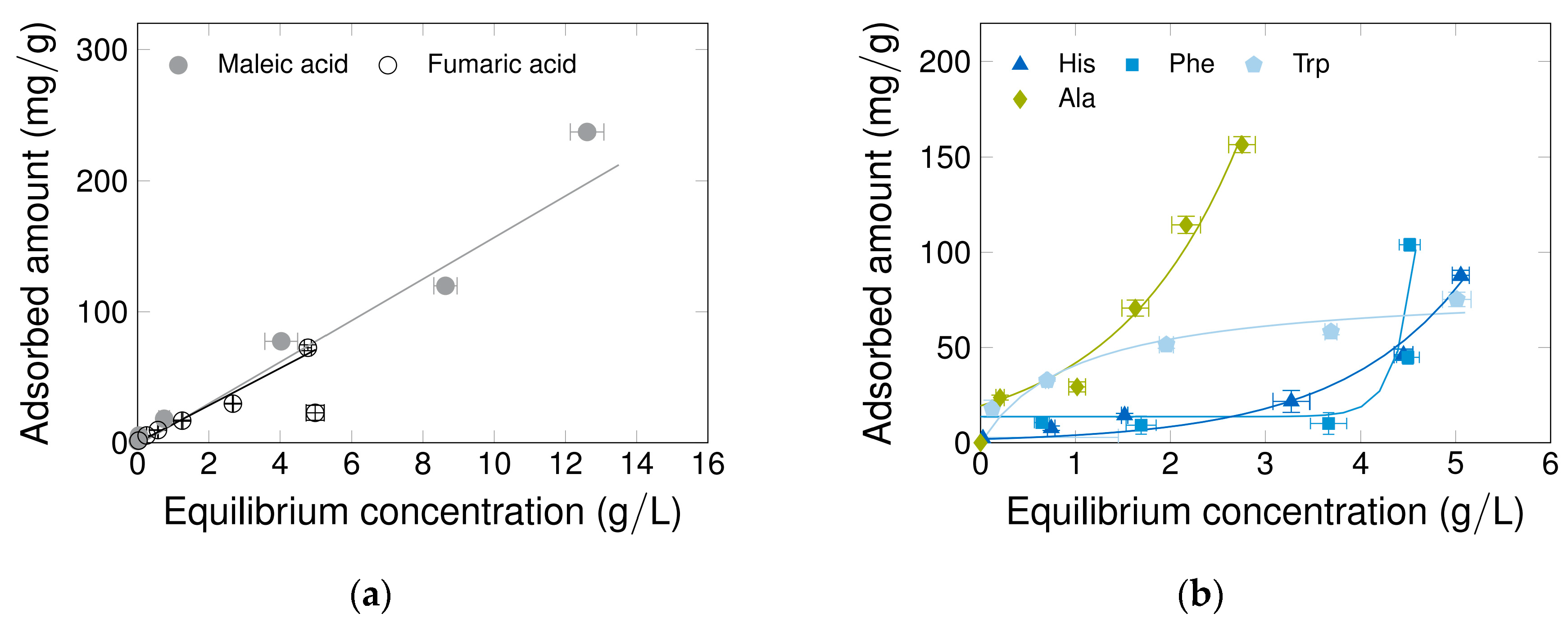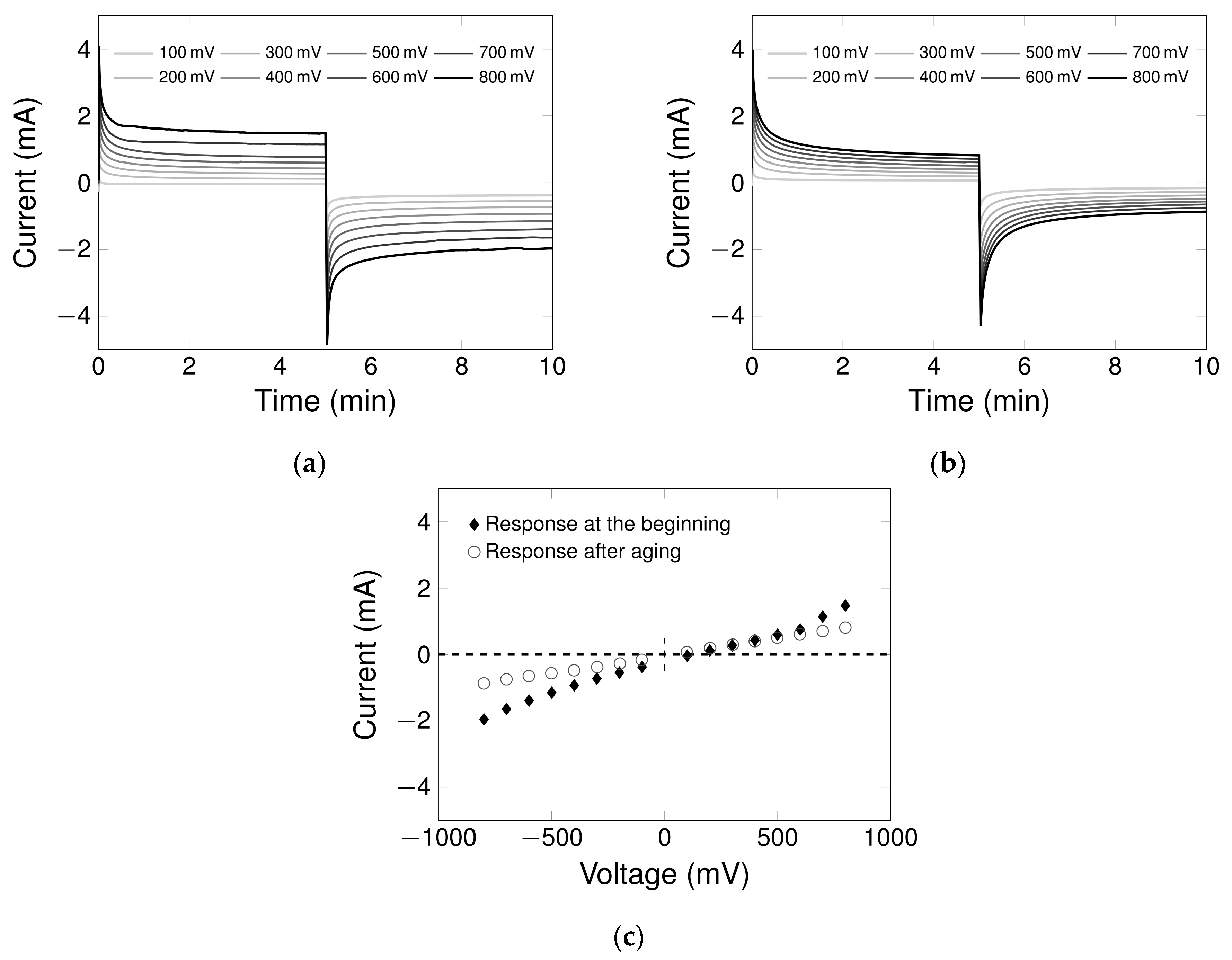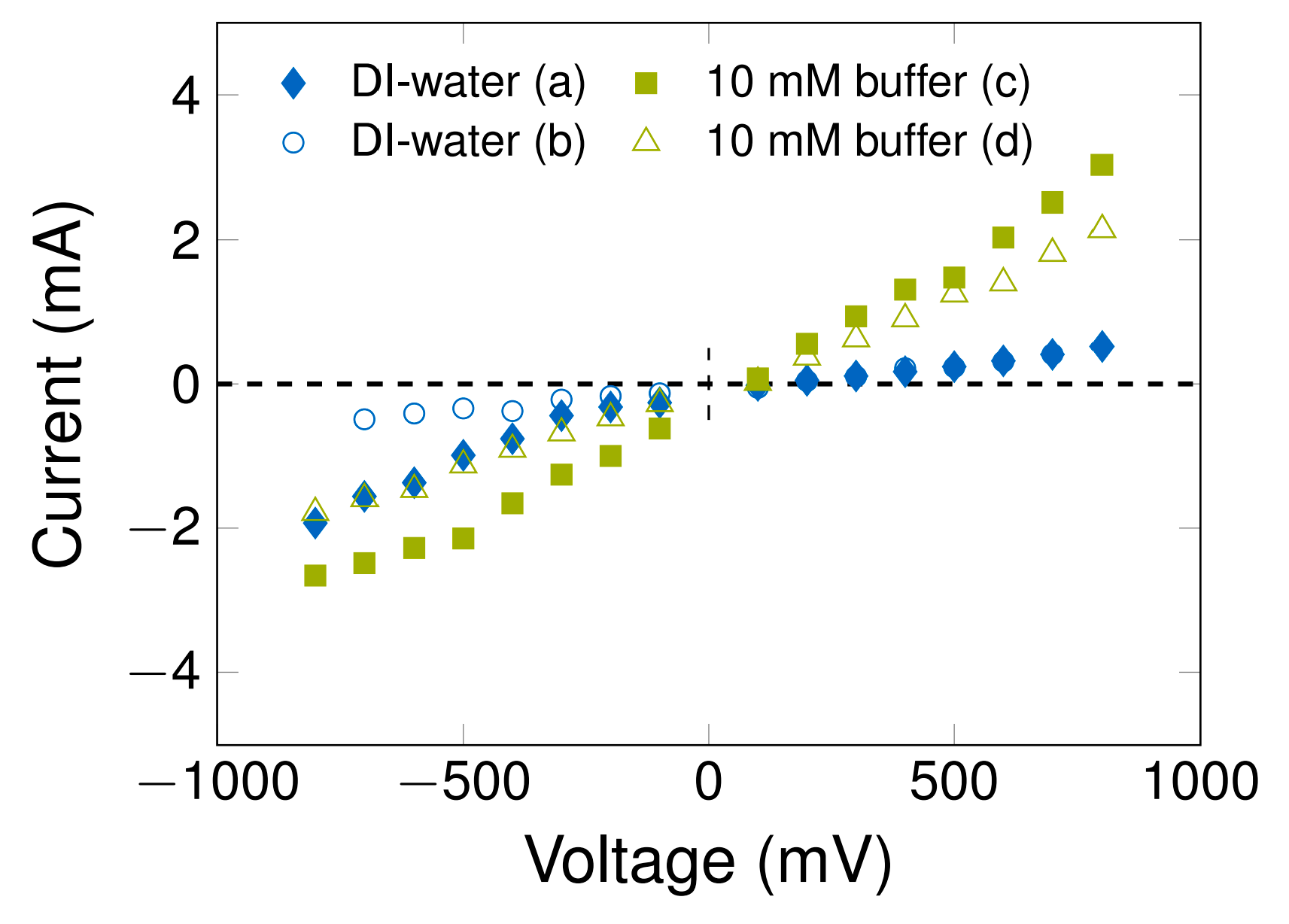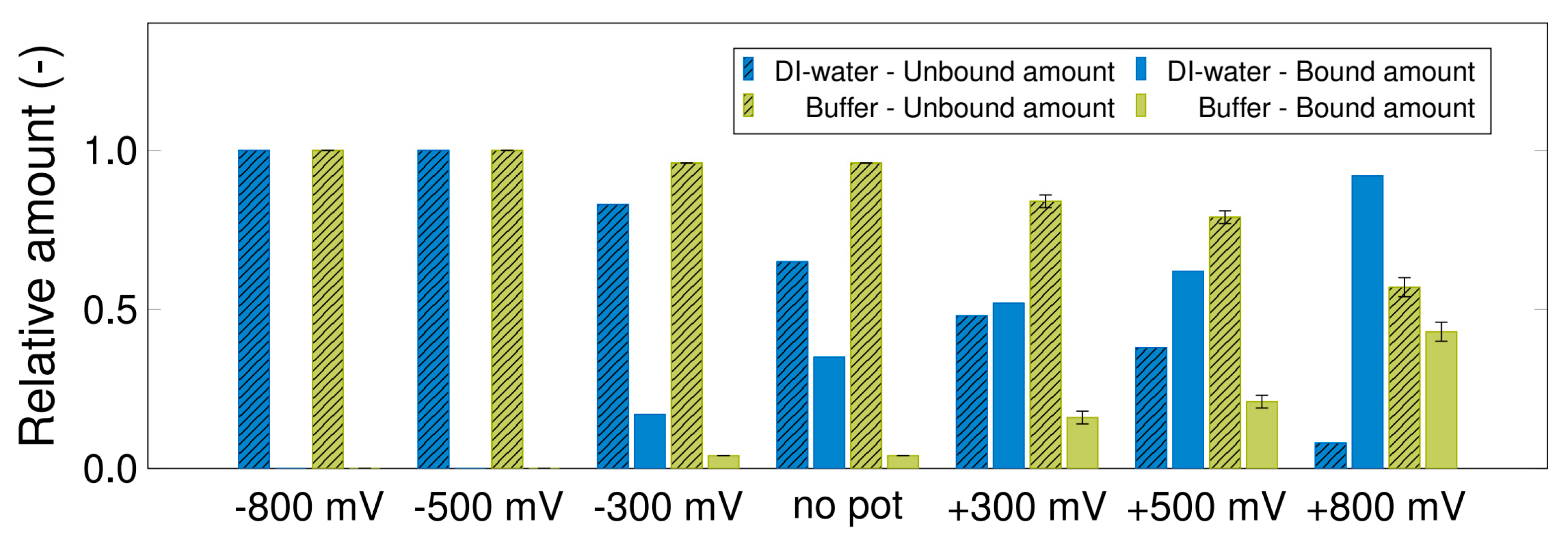A Carbon Nanotube Packed Bed Electrode for Small Molecule Electrosorption: An Electrochemical and Chromatographic Approach for Process Description
Abstract
Featured Application
Abstract
1. Introduction
2. Materials and Methods
2.1. Materials and Instrumentation
2.2. Electrochemical Experiments
2.3. Static Binding Experiments
2.4. Chromatographic Experiments
3. Results and Discussion
3.1. The Setup
3.2. Specific Properties of the Multi-Walled CNT-K
3.3. CNT-K Hydrophilicity and Surface Composition
3.4. Static Binding Capacity of CNT-K for Small Molecules
3.5. Electrochemical Characterization of the Packed Bed
3.6. Response of the System in Presence of Buffer Ions
3.7. Sensitivity of the Electrochemical Process to the Environment
3.8. Potential-Controlled Interaction between Electrode and a Charged Molecule: Influence on Retention and Elution
4. Conclusions and Outlook
Supplementary Materials
Author Contributions
Funding
Acknowledgments
Conflicts of Interest
References
- Fujinaga, T. Electrolytic chromatography and coulometric detection with the column electrode. J. Pure Appl. Chem. 1971, 25, 709–726. [Google Scholar] [CrossRef][Green Version]
- Fujinaga, T.; Kihara, S.; Bruckenstein, S. Electrolytic chromatography and coulopotentiography—A rapid electrolysis at the column electrode used for the preparation, separation, concentration, and estimation of trace and/or unstable substances. Crit. Rev. Anal. Chem. 1977, 6, 223–254. [Google Scholar] [CrossRef]
- Strohl, J.H.; Dunlap, K.L. Electrosorption and separation of quinones on a column of graphite particles. Anal. Chem. 1972, 44, 2166–2170. [Google Scholar] [CrossRef]
- Deinhammer, R.S. The development of novel chromatographic systems utilizing charge-controllable stationary phases for optimization of separation in liquid chromatography. Ph.D. Thesis, Iowa State University, Ames, Iowa, 1994. [Google Scholar]
- Nagaoka, T.; Fujimoto, M.; Nakao, H.; Kakuno, K.; Yano, J.; Ogura, K. Electrochemical separation of ionic compounds using a conductive stationary phase coated with polyaniline or polypyrrole film, and ion exchange properties of conductive polymers. J. Electroanal. Chem. 1994, 364, 179–188. [Google Scholar] [CrossRef]
- Ponton, L.M.; Porter, M.D. Electrochemically modulated liquid chromatographic separations of inorganic anions. J. Chrom. A 2004, 1059, 103–109. [Google Scholar] [CrossRef] [PubMed]
- Yakes, B.J.; Keller, D.W.; Porter, M.D. Electrochemically modulated liquid chromatographic separation of triazines and the effect of pH on retention. J. Chrom. A 2010, 4395–4401. [Google Scholar] [CrossRef]
- Okazaki, S. Fundamental studies on the electrolysis with the glassy carbon column electrode. Rev. Polarogr. 1968, 15, 154–167. [Google Scholar] [CrossRef]
- Tsuda, T. Electrochromatography using high applied voltage. Anal. Chem. 1987, 59, 521–523. [Google Scholar] [CrossRef]
- Ting, E.-Y.; Porter, M.D. Separations of benzodiazepines using electrochemically modulated liquid chromatography. J. Chrom. A 1998, 793, 204–208. [Google Scholar] [CrossRef]
- Ting, E.-Y.; Porter, M.D. Separations of corticosteroids using electrochemically modulated liquid chromatography: Selectivity enhancements at a porous graphitic carbon stationary phase. Anal. Chem. 1997, 69, 675–678. [Google Scholar] [CrossRef]
- Antrim, R.F.; Scherrer, R.A.; Yacynych, A.M. Electrochromatography—a preliminary study of the effect of applied potential on a carbonaceous chromatographic column. Anal. Chim. Acta 1984, 164, 283–286. [Google Scholar] [CrossRef]
- Antrim, R.F.; Yacynych, A.M. The effect of supporting electrolytes in electrochromatography. Anal. Lett. 1988, 21, 1085–1096. [Google Scholar] [CrossRef]
- Ge, H.; Wallace, G.G. Characterization of novel conducting polymeric stationary phases and electrochemically controlled high-performance liquid chromatography. Anal. Chem. 1989, 61, 2391–2394. [Google Scholar] [CrossRef]
- Porter, M.D.; Takano, H. Electrochemically modulated liquid chromatography. Chromatography II 2000, 636–646. [Google Scholar]
- Deinhammer, R.S.; Ting, E.-Y.; Porter, M.D. Electrochemically modulated liquid chromatography (EMLC): A new approach to gradient elution separations. J. Electroanal. Chem. 1993, 362, 295–299. [Google Scholar] [CrossRef]
- Ting, E.-Y.; Porter, M.D. Electrochemically modulated liquid chromatography (EMLC) as a probe of the adsorption characteristics of monosubstituted benzenes at porous graphitic carbon. J. Electroanal. Chem. 1998, 443, 180–185. [Google Scholar] [CrossRef]
- Harnisch, J.A.; Porter, M.D. Electrochemically modulated liquid chromatography: An electrochemical strategy for manipulating chromatographic retention. Analyst 2001, 126, 1841–1849. [Google Scholar] [CrossRef]
- Abdel-Latif, M.S.; Porter, M.D. Effects of electrolytes on manipulation of the stationary phase in electrochemically modulated liquid chromatography. Anal. Lett. 1998, 31, 1743–1756. [Google Scholar] [CrossRef]
- Ponton, L.M.; Keller, D.W.; Siperko, L.M.; Hayes, M.A.; Porter, M.D. Investigation of adsorption thermodynamics at electrified liquid–solid interfaces by electrochemically modulated liquid chromatography. J. Phys. Chem. C 2019, 123, 28148–28157. [Google Scholar] [CrossRef]
- Soto, R.J.; Hayes, M.A.; Porter, M.D. Electrochemically modulated liquid chromatography in fused silica capillary columns. Anal. Chem. 2019, 91, 13994–14001. [Google Scholar] [CrossRef]
- Nagaoka, T.; Nakao, N.; Tabusa, K.; Yano, J.; Ogura, K. Dynamic elution control in electrochemical ion chromatography using pulse perturbation of stationary phase potential. J. Electroanal. Chem. 1994, 371, 283–286. [Google Scholar] [CrossRef]
- Muna, G.W.; Swope, V.M.; Swain, G.M.; Porter, M.D. Electrochemically modulated liquid chromatography using a boron-doped diamond particle stationary phase. J. Chromatogr. A 2008, 1210, 154–159. [Google Scholar] [CrossRef] [PubMed][Green Version]
- Keller, D.W.; Ponton, L.M.; Porter, M.D. Assessment of supporting electrolyte contributions in electrochemically modulated liquid chromatography. J. Chromatogr. A 2005, 1089, 72–81. [Google Scholar] [CrossRef] [PubMed]
- Abdel-Latif, M. Effect of electrolytes on the retention behavior of some benzenesulfonates in electrochemically modulated liquid chromatography. Talanta 1998, 47, 681–687. [Google Scholar] [CrossRef]
- Knizia, M.W.; Vuorilehto, K.; Schrader, J.; Sell, D. Potential-controlled chromatography of short-chain carboxylic acids. Electroanalysis 2003, 15, 49–54. [Google Scholar] [CrossRef]
- Kocak, F.; Vuorilehto, K.; Schrader, J.; Sell, D. Potential-controlled chromatography for the separation of amino acids and peptides. J. Appl. Electrochem. 2005, 35, 1231–1237. [Google Scholar] [CrossRef]
- Brammen, M.; Fraga-Garcia, P.; Berensmeier, S. Carbon nanotubes-A resin for electrochemically modulated liquid chromatography. J. Sep. Sci. 2016, 1–9. [Google Scholar] [CrossRef]
- Speltini, A.; Merli, D.; Profumo, A. Analytical application of carbon nanotubes, fullerenes and nanodiamonds in nanomaterials-based chromatographic stationary phases: A review. Anal. Chim. Acta 2013, 783, 1–16. [Google Scholar] [CrossRef]
- Li, Y.; Chen, Y.; Xiang, R.; Ciuparu, D.; Pfefferle, L.D.; Horváth, C.; Wilkins, J.A. Incorporation of single-wall carbon nanotubes into an organic polymer monolithic stationary phase for mu-HPLC and capillary electrochromatography. Anal. Chem. 2005, 77, 1398–1406. [Google Scholar] [CrossRef]
- Chang, Y.X.; Zhou, L.L.; Li, G.X.; Li, L.; Yuan, L.M. Single-wall carbon nanotubes used as stationary phase in HPLC. J. Liq. Chrom. Relat. Tech. 2007, 30, 2953–2958. [Google Scholar] [CrossRef]
- Zhao, L.; Ai, P.; Duan, A.-H.; Yuan, L.-M. Single-walled carbon nanotubes for improved enantioseparations on a chiral ionic liquid stationary phase in GC. Anal. Bioanal. Chem. 2011, 399, 143–147. [Google Scholar] [CrossRef] [PubMed]
- André, C.; Gharbi, T.; Guillaume, Y.-C. A novel stationary phase based on amino derivatized nanotubes for HPLC separations: Theoretical and practical aspects. J. Sep. Sci. 2009, 32, 1757–1764. [Google Scholar] [CrossRef] [PubMed]
- Rubianes, M.D.; Rivas, G.A. Carbon nanotubes paste electrode. Electrochem. Commun. 2003, 5, 689–694. [Google Scholar] [CrossRef]
- Nasrabadi, A.T.; Foroutan, M. Ion-separation and water-purification using single-walled carbon nanotube electrodes. Desalination 2011, 277, 236–243. [Google Scholar] [CrossRef]
- Ratajczak, P.; Suss, M.E.; Kaasik, F.; Béguin, F. Carbon electrodes for capacitive technologies. Energy Storage Mater. 2019, 16, 126–145. [Google Scholar] [CrossRef]
- Bulusheva, L.G.; Okotrub, A.V.; Kurenya, A.G.; Zhang, H.; Zhang, H.; Chen, X.; Song, H. Electrochemical properties of nitrogen-doped carbon nanotube anode in Li-ion batteries. Carbon 2011, 49, 4013–4023. [Google Scholar] [CrossRef]
- Saeed, K.; Kahn, I. Carbon nanotubes - properties and applications: A review. Carbon letters 2013, 131–144. [Google Scholar]
- Yang, E.; Thordarson, P.; Gooding, J.; Ringer, S.; Braet, F. Carbon nanotubes for biological and biomedical application. Nanotechnology 2007, 18, 412001. [Google Scholar] [CrossRef]
- Li, C.; Thostenson, E.T.; Chou, T.-W. Sensors and actuators based on carbon nanotubes and their composites: A review. Compos. Sci. Technol. 2008, 68, 1227–1249. [Google Scholar] [CrossRef]
- Iijima, S. Carbon nanotubes: Past, present, and future. Physica B 2002, 323, 1–5. [Google Scholar] [CrossRef]
- Han, C.; Shi, R.; Zhou, D.; Li, H.; Xu, L.; Zhang, T.; Li, J.; Kang, F.; Wang, G.; Li, B. High-energy and high-power nonaqueous lithium-ion capacitors based on polypyrrole/carbon nanotube composites as pseudocapacitive cathodes. ACS Appl. Mater. Interfaces 2019, 11, 15646–15655. [Google Scholar] [CrossRef] [PubMed]
- Liu, Z.; Yuan, X.; Zhang, S.; Wang, J.; Huang, Q.; Yu, N.; Zhu, Y.; Fu, L.; Wang, F.; Chen, Y.; et al. Three-dimensional ordered porous electrode materials for electrochemical energy storage. NPG Asia Mater. 2019, 11, 12. [Google Scholar] [CrossRef]
- Krieg, T.; Sydow, A.; Schröder, U.; Schrader, J.; Holtmann, D. Reactor concepts for bioelectrochemical syntheses and energy conversion. Trends Biotechnol. 2014, 32, 645–655. [Google Scholar] [CrossRef]
- Al-zubaidi, A.; Inoue, T.; Matsushita, T.; Ishii, Y.; Hashimoto, T.; Kawasaki, S. Cyclic voltammogram profile of single-walled carbon nanotube electric double-layer capacitor electrode reveals dumbbell shape. J. Phys. Chem. C 2012, 116, 7681–7686. [Google Scholar] [CrossRef]
- Kaempgen, M. Eigenschaften und Anwendungen von Netzwerken aus Kohlenstoff-Nanoröhren. Ph.D. Thesis, Universität Stuttgart, Stuttgart, Germany, 2006. [Google Scholar]
- Peigney, A.; Laurent, C.; Flahaut, E.; Bacsa, R.R.; Rousset, A. Specific surface area of carbon nanotubes and bundles of carbon nanotubes. Carbon 2001, 39, 507–514. [Google Scholar] [CrossRef]
- Birch, M.E.; Ruda-Eberenz, T.A.; Chai, M.; Andrews, R.; Hatfield, R.L. Properties that influence the specific surface areas of carbon nanotubes and nanofibers. Ann. Occup. Hyg. 2013, 57, 1148–1166. [Google Scholar] [CrossRef] [PubMed][Green Version]
- Frackowiak, E.; Metenier, K.; Bertagna, V.; Beguin, F. Supercapacitor electrodes from multiwalled carbon nanotubes. Appl. Phys. Lett. 2000, 77, 2421–2423. [Google Scholar] [CrossRef]
- Li, S.; Li, H.; Wang, X.; Song, Y.; Liu, Y.; Jiang, L.; Zhu, D. Super-hydrophobicity of large-area honeycomb-like aligned carbon nanotubes. J. Phys. Chem. B 2002, 106, 9274–9276. [Google Scholar] [CrossRef]
- Shanmugam, S.; Gedanken, A. Generation of hydrophilic, bamboo-shaped multiwalled carbon nanotubes by solid-state pyrolysis and its electrochemical studies. J. Phys. Chem. B 2006, 110, 2037–2044. [Google Scholar] [CrossRef]
- Gogotsi, Y.; Naguib, N.; Libera, J.A. In situ chemical experiments in carbon nanotubes. Chem. Phys. Lett. 2002, 365, 354–360. [Google Scholar] [CrossRef]
- Ye, J.-S.; Liu, X.; Cui, H.F.; Zhang, W.-D.; Sheu, F.-S.; Lim, T.M. Electrochemical oxidation of multi-walled carbon nanotubes and its application to electrochemical double layer capacitors. Electrochem. Commun. 2005, 7, 249–255. [Google Scholar] [CrossRef]
- Schwaminger, S.P.; Begovic, B.; Schick, L.; Jumani, N.A.; Brammen, M.W.; Fraga-García, P.; Berensmeier, S. Potential-controlled tensiometry: A tool for understanding wetting and surface properties of conductive powders by electroimbibition. Anal. Chem. 2018, 90, 14131–14136. [Google Scholar] [CrossRef] [PubMed]
- Tomo, Y.; Askounis, A.; Ikuta, T.; Takata, Y.; Sefiane, K.; Takahashi, K. Superstable ultrathin water film confined in a hydrophilized carbon nanotube. Nano Lett. 2018, 18, 1869–1874. [Google Scholar] [CrossRef] [PubMed]
- Ndunda, E.N.; Mizaikoff, B. Multi-walled carbon nanotubes: Innovative sorbents for pre-concentration of polychlorinated biphenyls in aqueous environments. Anal. Methods 2015, 7, 8034–8040. [Google Scholar] [CrossRef]
- Zajíčková, L.; Kučerová, Z.; Buršíková, V.; Eliáš, M.; Houdková, J.; Synek, P.; Maršíková, H.; Jašek, O. Carbon Nanotubes Functionalized in Oxygen and Water Low Pressure Discharges used as Reinforcement of Polyurethane Composites. Plasma Processes Polym. 2009, 6, S864–S869. [Google Scholar] [CrossRef]
- Cheng, X.; Zhong, J.; Meng, J.; Yang, M.; Jia, F.; Xu, Z.; Kong, H.; Xu, H. Characterization of multiwalled carbon nanotubes dispersing in water and association with biological effects. J. Nanomater. 2011, 2011, 1–12. [Google Scholar] [CrossRef]
- Törnkvist, A.; Markides, K.E.; Nyholm, L. Chromatographic behaviour of oxidised porous graphitic carbon columns. Analyst 2003, 128, 844–848. [Google Scholar] [CrossRef]
- Balavoine, F.; Schultz, P.; Richard, C.; Mallouh, V.; Ebbesen, T.W.; Mioskowski, C. Helical crystallization of proteins on carbon nanotubes: A first step towards the development of new biosensors. Angew. Chem. Int. 1999, 38, 1912–1915. [Google Scholar] [CrossRef]
- Barisci, J.N.; Wallace, G.G.; Chattopadhyay, D.; Papadimitrakopoulos, F.; Baughman, R.H. Electrochemical properties of single-wall carbon nanotube electrodes. J. Electrochem. Soc. 2003, 150, E409. [Google Scholar] [CrossRef]
- Hodge, S.A.; Fogden, S.; Howard, C.A.; Skipper, N.T.; Shaffer, M.S.P. Electrochemical processing of discrete single-walled carbon nanotube anions. ACS Nano 2013, 7, 1769–1778. [Google Scholar] [CrossRef]
- Saitoh, K.; Koichi, K.; Yabiku, F.; Noda, Y.; Porter, M.D.; Shibukawa, M. On-column electrochemical redox derivatization for enhancement of separation selectivity of liquid chromatography use of redox reaction as secondary chemical equilibrium. J. Chromatogr. A 2008, 1180, 66–72. [Google Scholar] [CrossRef] [PubMed]
- Hossain, M.M.; Islam, M.A.; Shima, H.; Hasan, M.; Lee, M. Alignment of carbon nanotubes in carbon nanotube fibers through nanoparticles: A route for controlling mechanical and electrical properties. Appl. Mater. Inter. 2017, 9, 5530–5542. [Google Scholar] [CrossRef] [PubMed]
- Minnikanti, S.; Skeath, P.; Peixoto, N. Electrochemical characterization of multi-walled carbon nanotube coated electrodes for biological applications. Carbon 2009, 47, 884–893. [Google Scholar] [CrossRef]
- Pan, L.; Wang, X.; Gao, Y.; Zhang, Y.; Chen, Y.; Sun, Z. Electrosorption of anions with carbon nanotube and nanofibre composite film electrodes. Desalination 2009, 244, 139–143. [Google Scholar] [CrossRef]
- Chen, J.H.; Li, W.Z.; Wang, D.Z.; Yang, S.X.; Wen, J.G.; Ren, Z.F. Electrochemical characterization of carbon nanotubes as electrode in electrochemical double-layer capacitors. Carbon 2002, 40, 1193–1197. [Google Scholar] [CrossRef]
- Gu, W.; Yushin, G. Review of nanostructured carbon materials for electrochemical capacitor applications: Advantages and limitations of activated carbon, carbide-derived carbon, zeolite-templated carbon, carbon aerogels, carbon nanotubes, onion-like carbon, and graphene. WIREs Energy Environ. 2014, 3, 424–473. [Google Scholar] [CrossRef]







| Sample | O/C |
|---|---|
| Untreated powder | 0.057 |
| Conditioned CNT-K | 0.069 |
| CNT-K packed bed column 1 | 0.165 |
| CNT-K packed bed column 2 | 0.138 |
| CNT-K packed bed column 3 | 0.142 |
© 2020 by the authors. Licensee MDPI, Basel, Switzerland. This article is an open access article distributed under the terms and conditions of the Creative Commons Attribution (CC BY) license (http://creativecommons.org/licenses/by/4.0/).
Share and Cite
Trunzer, T.; Stummvoll, T.; Porzenheim, M.; Fraga-García, P.; Berensmeier, S. A Carbon Nanotube Packed Bed Electrode for Small Molecule Electrosorption: An Electrochemical and Chromatographic Approach for Process Description. Appl. Sci. 2020, 10, 1133. https://doi.org/10.3390/app10031133
Trunzer T, Stummvoll T, Porzenheim M, Fraga-García P, Berensmeier S. A Carbon Nanotube Packed Bed Electrode for Small Molecule Electrosorption: An Electrochemical and Chromatographic Approach for Process Description. Applied Sciences. 2020; 10(3):1133. https://doi.org/10.3390/app10031133
Chicago/Turabian StyleTrunzer, Tatjana, Timothy Stummvoll, Melanie Porzenheim, Paula Fraga-García, and Sonja Berensmeier. 2020. "A Carbon Nanotube Packed Bed Electrode for Small Molecule Electrosorption: An Electrochemical and Chromatographic Approach for Process Description" Applied Sciences 10, no. 3: 1133. https://doi.org/10.3390/app10031133
APA StyleTrunzer, T., Stummvoll, T., Porzenheim, M., Fraga-García, P., & Berensmeier, S. (2020). A Carbon Nanotube Packed Bed Electrode for Small Molecule Electrosorption: An Electrochemical and Chromatographic Approach for Process Description. Applied Sciences, 10(3), 1133. https://doi.org/10.3390/app10031133







